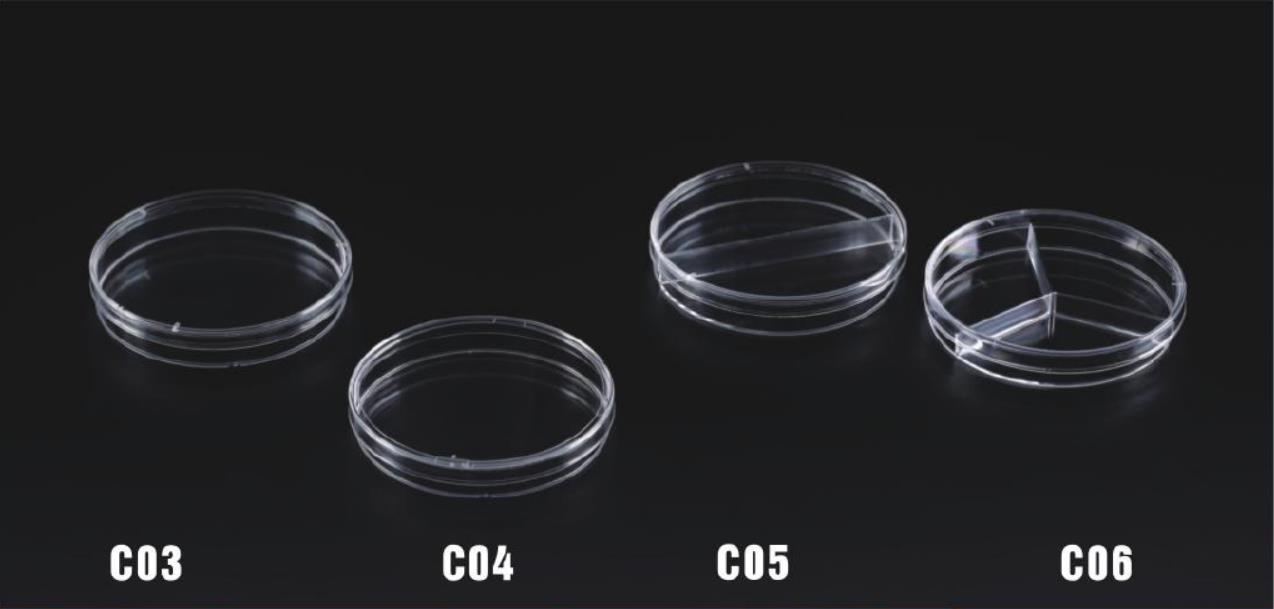Petri dishes, also known as culture dishes, are essential tools in laboratory settings for the cultivation and observation of microorganisms and cells. These cylindrical, shallow dishes come in various sizes and materials, providing a controlled environment for growth and research. Whether you work in microbiology, cell biology, or other scientific disciplines, understanding the uses, materials, and best practices for Petri dishes is vital for successful laboratory culture experiments. In this article, we will dive into all things Petri dish, uncovering their applications, materials, and tips for achieving optimal results in your research.
Item No | Description | Spec.(mm) | Packing Info. | Qty./Case(pc) | Case Size(cm) |
C03 | 90mm Petri Dish,Sterile,Size:¢92.5mm | ¢92.5*15 | 10pcs/bag X 50 | 500 | 49X49X34 |
C04 | 90mm Petri Dish,Sterile,Size:¢90mm | ¢90*15 | 10pcs/bag X 50 | 500 | 49X49X34 |
C05 | PETRI DISH 90mm, 2 compartments | ¢90*15 | 10pcs/bag X 50 | 500 | 49X49X34 |
C06 | PETRI DISH 90mm, 3 compartments | ¢90*15 | 10pcs/bag X 50 | 500 | 49X49X34 |

Petri dishes, widely used in laboratory culture, serve as indispensable tools for cultivating and observing microorganisms and cells. These shallow, cylindrical laboratory dishes provide researchers with a controlled environment for growth and experimentation. With their diverse applications across various scientific disciplines, understanding the uses, materials, and best practices for Petri dishes is crucial for successful laboratory culture experiments.
The primary use of Petri dishes lies in microbiology, where they enable the isolation and cultivation of microorganisms for further study. These dishes act as a welcoming environment for bacteria, fungi, and other microbes, allowing researchers to observe, identify, and characterize them. Furthermore, Petri dishes play a vital role in antibiotic susceptibility testing and the evaluation of antimicrobial compounds.
In addition to microbiology, Petri dishes are widely employed in cell biology and tissue culture research. They provide a sterile, flat surface for the growth and maintenance of cells, making them suitable for a range of cell-based experiments. Petri dishes also enable the creation of monolayer cultures, facilitating observations of cell morphology, proliferation, and differentiation. Moreover, these dishes are utilized in cloning, cloning efficiency assessments, and various molecular biology techniques.
Petri dishes are available in different materials, each with its own unique characteristics and applications. Glass Petri dishes offer excellent transparency and chemical resistance, making them suitable for long-term cell culture experiments and microscopy observations. Plastic Petri dishes, usually made of polystyrene, are preferred for their lightweight, disposable nature, making them convenient for routine laboratory work. Additionally, certain plastic Petri dishes are designed with ventilation options, facilitating aerobic or anaerobic growth conditions for specific microorganisms.
To ensure successful laboratory culture experiments, several best practices should be followed when working with Petri dishes. First and foremost, maintaining sterility is crucial. Proper aseptic techniques, such as wearing Gloves, working in a laminar flow hood, and sterilizing equipment, prevent contamination and yield reliable results. Proper labeling of dishes, using appropriate growth media, and suitable incubation conditions are also vital for successful culture experiments.
In summary, Petri dishes are versatile tools in laboratory culture, serving as the foundation for microbiology and cell biology research. Understanding their various applications, materials, and best practices is essential for achieving reliable and reproducible results. Whether you are studying microorganisms or working with cells, the proper use of Petri dishes can significantly impact the success of your laboratory culture experiments, contributing to scientific advancements and discoveries.

Contact: Neo
Phone: 008615867460640
E-mail: Info@Hwtai.com
Whatsapp:008615867460640
Add: Building 2, Xinmao Qilu Science Technology Industrial Park, Tianqiao District, Jinan City, Shandong Province,China.
We chat
